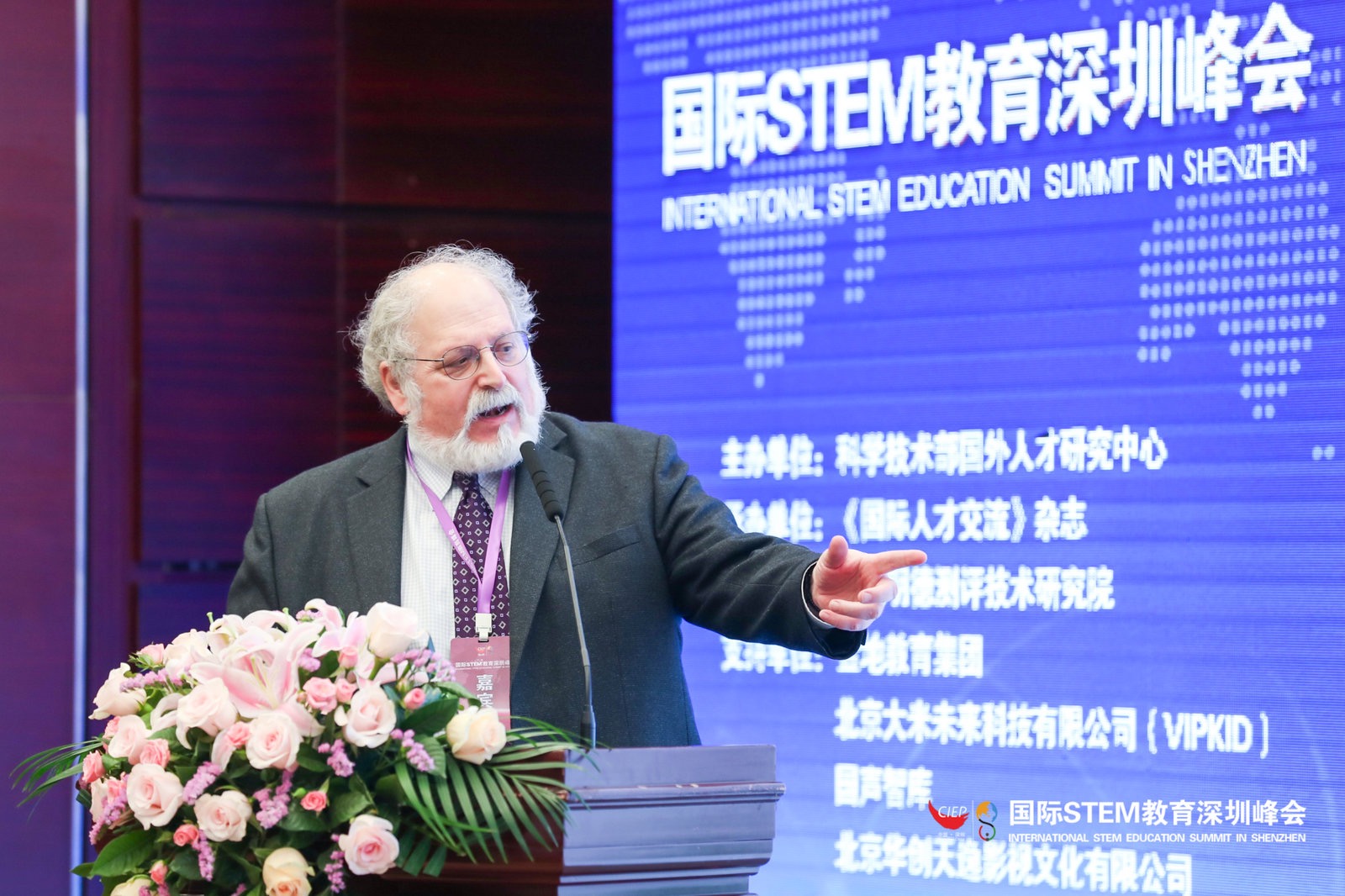Building a Research Capability at Duke Kunshan University
By Denis Simon
For five years, from August 2015 to June 2020, I had the opportunity to live and work in China. I served as Executive Vice Chancellor of Duke Kunshan University, a Sino-US joint venture involving Duke University, Wuhan University, and the city of Kunshan in Jiangsu province. This was a unique opportunity because not only did it involve developing a new undergraduate degree program and expanding the number of graduate degree programs, but it also included developing a credible, high caliber research capability within the university. This part of the experience was both rewarding and challenging as it occurred during a period of growing tensions between the US and China regarding IPR issues, technology transfer, and scholarly exchanges.

Dr. Denis Simon is speaking at the International STEM Education Summit in Shenzhen.
One of the hallmarks of DKU is that it places great emphasis on both interdisciplinary teaching and research. By the time I completed my five year tenure at DKU, there were eleven research centers in place, including centers focused on global health, international environment, applied sciences, China S&T policy, and mathematics and computational sciences. Of course, securing adequate funding to support these centers has always been a challenge, especially for non-Chinese researchers who are not familiar with obtaining grants from Chinese sources. That said, our faculty has became increasingly successful at securing research grants from municipal, provincial and national sources in China. DKU also has attracted funding from foundations and a series of generous local donors. In addition, our Global Health Research Center was designated a regional research hub by the WHO, which helped bring in research funding from international and regional sources.
A second challenge has been developing research projects that can stay clear of the growing constraints associated with expanded research controls coming from the US government. Those DKU scholars who are US citizens continue to be bound by the export control policies of the American government, especially with respect to topics such as semiconductors, artificial intelligence, and advanced computing. Fortunately, there are numerous issues of shared concern between the US and China in fields such as health, environment, medical physics, etc. that allow DKU researchers to stay clear of current constraints and limitations. One interesting project has involved research on the impact of ozone levels on the health of residents in the Yangtze River Delta region.
A third challenge has been to select research topics that might yield some type of commercially relevant technologies. The city of Kunshan, the main financial investor in the joint venture, originally invited Duke to set up a campus in the city because it apparently wanted to replicate the experience of Stanford University and Silicon Valley in California. Kunshan officials were anxious to capture technology transfers from the university as part of its efforts to transition its manufacturing oriented economy into a knowledge-driven, innovation oriented economy. Clearly, the presence of DKU in Kunshan has raised the profile of the city with DKU being the site of many important STEM-related international and domestic conferences and seminars.
The final challenge we have faced has been attracting the type of high-end talent that could produce world class research results with possible commercial applications. During my leadership and with the sustained help of colleagues from Duke University, we recruited over 125 new faculty from 13 different countries across the globe, including the US and Europe. It has been much easier to attract faculty in the social sciences and humanities than in science and mathematics because many of the scholars in the former category are focused on research topics linked to China studies—past, present and future. Attracting STEM faculty has proven more challenging because of the huge cost of building up research facilities and the fact that many people in this category have lacked partners or other connections in the Chinese scientific community. Gradually, but steadily, several of these types of hurdles have been overcome, but many still remain. Nonetheless, the quality of teaching and research remains high caliber and the research performance of many of the existing STEM faculty, along with colleagues in social sciences and humanities, has been outstanding by all measures and indicators.
Overall, I believe it is safe to say that the effort to build a research capability at DKU has been a great success. The emphasis on innovation and S&T development in China has dovetailed nicely with the university’s desire to enhance and expand its research activities. Since DKU remains largely an undergraduate liberal arts university with only five graduate degrees, the university is not aiming to become a comprehensive research university such as Duke University or Wuhan University. That recognized, the leadership and faculty at DKU believe strongly that undergraduate students should participate in research projects and new knowledge discovery as part of their core education experience. Involving DKU students in these research projects provides them an understanding and appreciation of intellectual property rights and protection. It also helps them better grasp the importance of the scientific method as well as the creative process for developing new knowledge.
In the final analysis, given the fact that a joint venture university represents the ultimate form of true collaboration between the US and China, it is hoped that Washington and Beijing can sort out their current differences so that research collaboration and S&T cooperation can proceed ahead in a mutually beneficial manner. At present, there is no global S&T-related problem whose meaningful solution will not depend on close Sino-US cooperation. This includes everything from tracking and preventing future global pandemics to developing cleaner, more reliable sources of renewable energy. My hope is that DKU will continue to play a role as a bridge builder that can contribute research results that not only benefit the US and China, but also the entire world. As someone whose own research for the last four decades has been focused on the study of S&T development in contemporary China, it has been a wonderful experience actually helping to create the type of research organization that I used to study from afar.
Denis Simon is Executive Director, Center for Innovation Policy of Duke University. The views don't necessarily reflect those of the S&T Daily.

